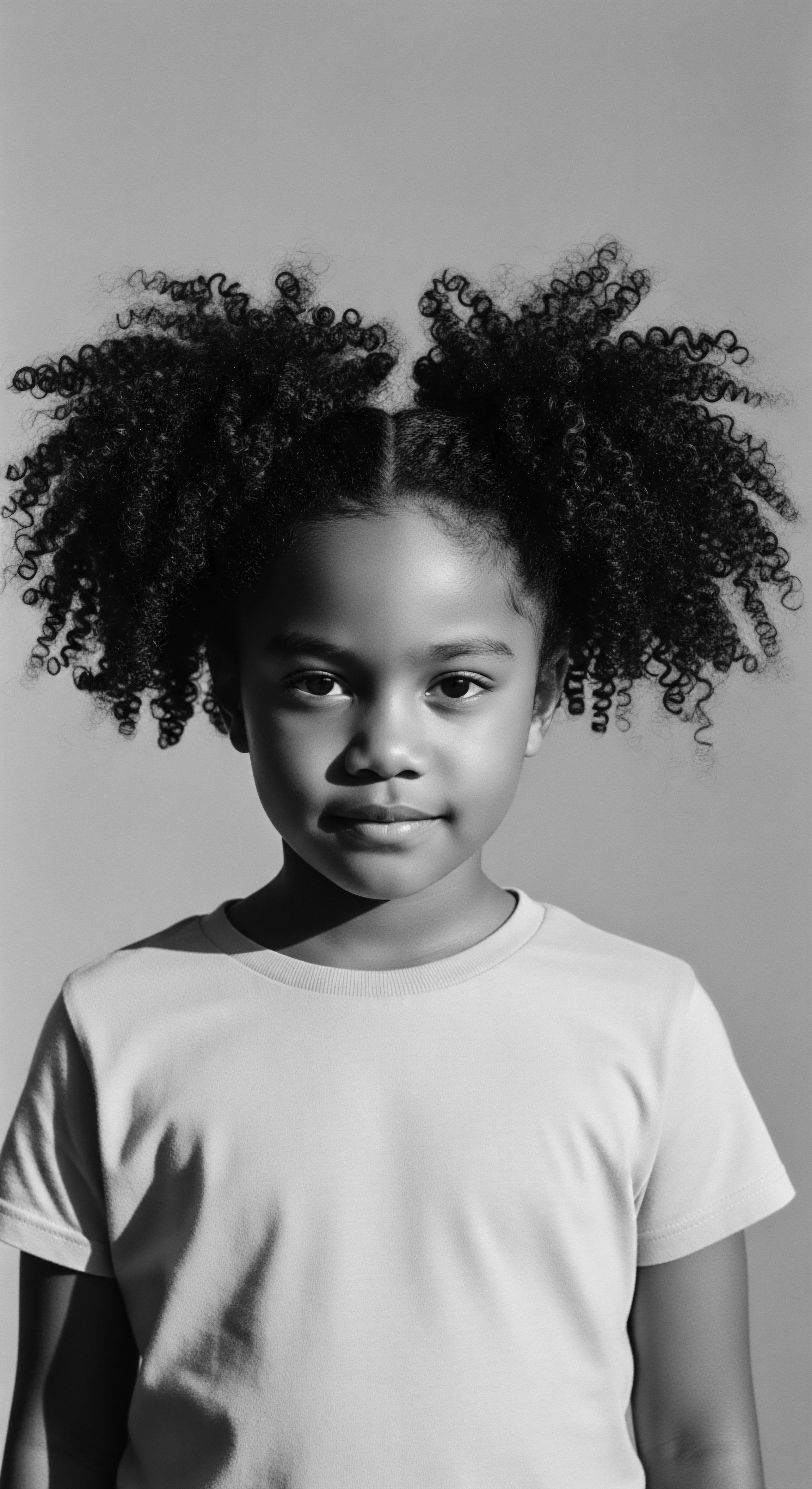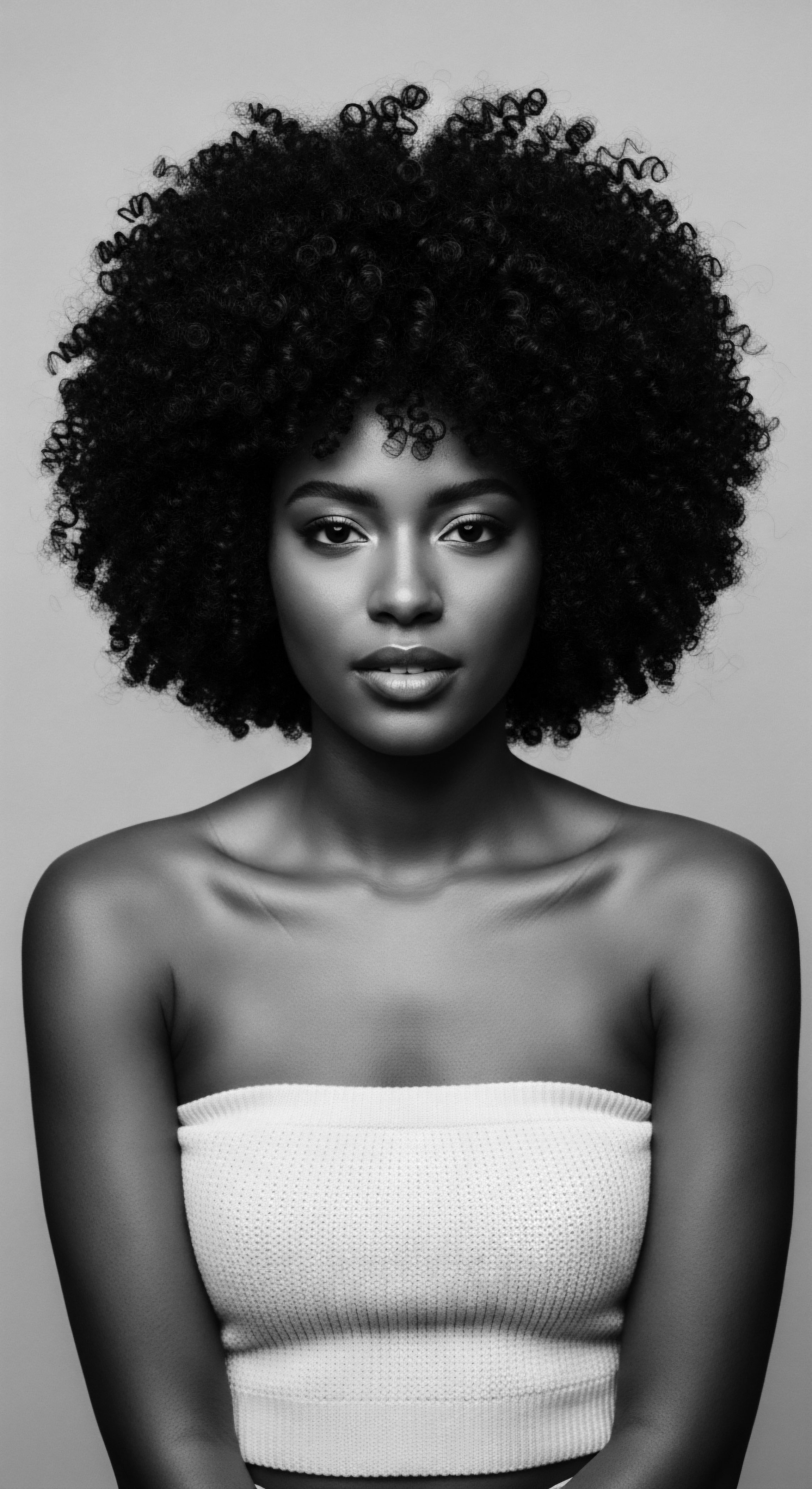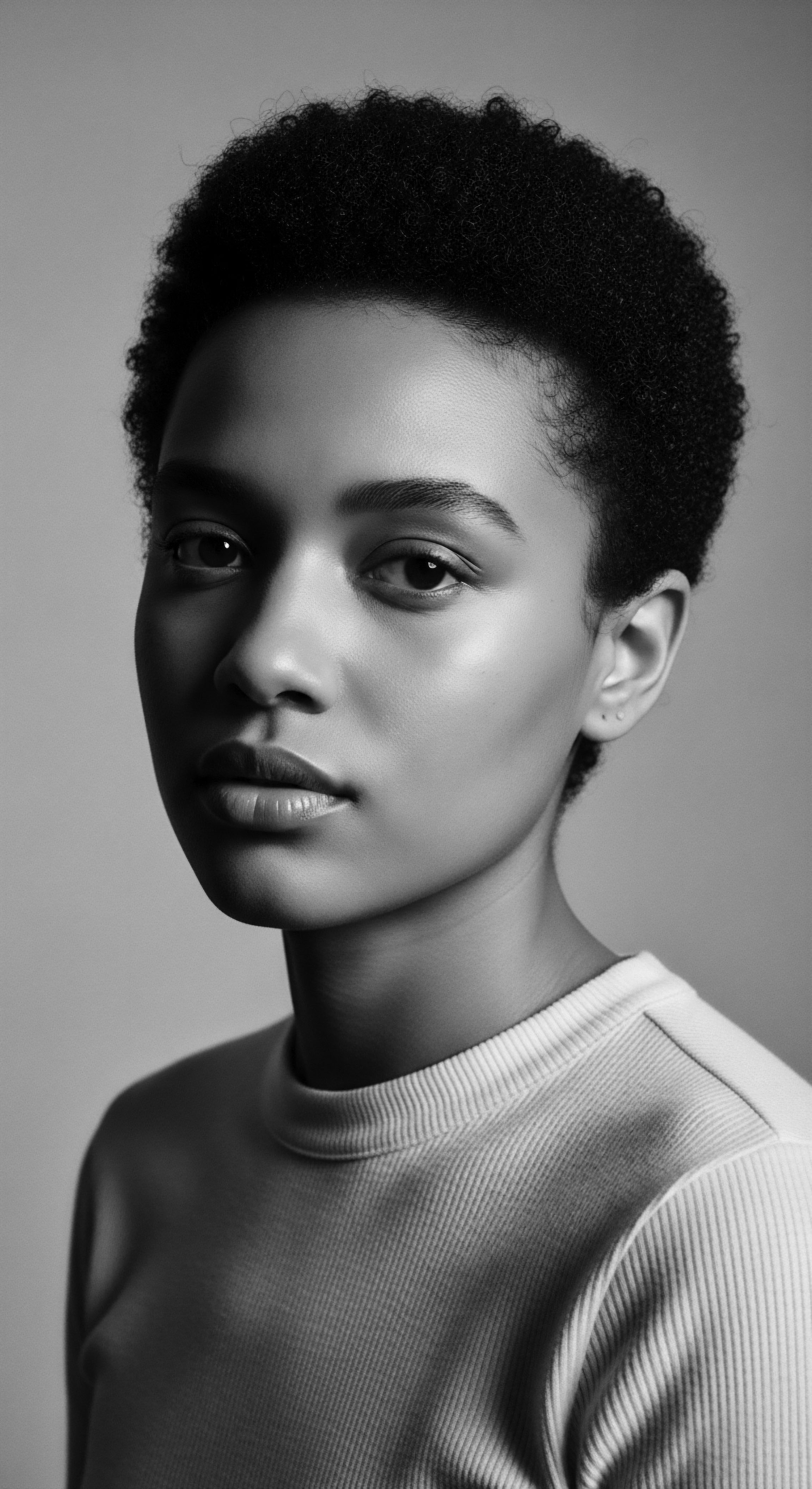
Fundamentals
The notion of the ‘Unbound Helix’ within Roothea’s living library transcends a mere scientific definition; it serves as a profound explanation of the inherent resilience, diverse forms, and cultural significance embedded within textured hair. At its most fundamental, it refers to the spiraling, coiling, or zigzagging patterns that define the very structure of hair strands, particularly those of Black and mixed-race heritage. This spiraled architecture, visible under magnification, is the physical manifestation of the Unbound Helix.
Its meaning extends to the unique properties that arise from this form, such as volume, elasticity, and a remarkable capacity for intricate styling. This designation acknowledges that these hair patterns are not deviations from a norm, but rather expressions of unparalleled beauty and strength, deeply rooted in ancestral lineages.
For those new to the conversation, envisioning the Unbound Helix begins with observing a single strand of textured hair. Instead of a smooth, straight line, one might perceive a series of curves, bends, or tight coils. This distinct physical characteristic, determined by the shape of the hair follicle itself, is the starting point of understanding.
The way these individual strands interact, intertwine, and respond to moisture and manipulation is a direct consequence of their helical nature. It is this foundational understanding that allows us to move beyond superficial observations and appreciate the intrinsic qualities of textured hair.
The Unbound Helix is the elemental blueprint of textured hair, a coiled testament to its unique strength and expressive capacity.
The term ‘helix’ itself, originating from the Greek word ‘ἕλιξ’ meaning “twisted, curved,” describes a three-dimensional spiral shape, much like a coil spring or the thread of a screw. In biology, this form is famously observed in the DNA molecule, which consists of two intertwined helices. When applied to hair, the Unbound Helix speaks to the intricate structural arrangement of keratin proteins within the hair shaft, particularly the alpha-keratins that form the mechanical support of the hair fiber. These proteins, rich in cysteine, create disulfide bonds that establish a cross-linking network, responsible for hair’s elasticity and toughness.
In textured hair, this helical arrangement is pronounced, contributing to its distinctive shape and behavior. The clarification of Unbound Helix helps us understand why textured hair possesses such unique attributes, distinguishing it from hair with a straighter conformation.
To further grasp this initial delineation, consider the variations in hair texture, often categorized by curl pattern. These patterns, from loose waves to tight coils, are all expressions of the Unbound Helix, each possessing its own particular requirements for care and adornment. The Roothea perspective champions this diversity, recognizing that each variation carries its own historical echoes and cultural significance. The initial explication of the Unbound Helix sets the stage for a deeper exploration of how this biological reality has shaped, and continues to shape, the lived experiences of Black and mixed-race individuals across generations.

Intermediate
Moving beyond the fundamental description, the Unbound Helix assumes a more expansive meaning within the realm of textured hair, particularly when considering its heritage. It is not merely a biological structure but a living symbol, embodying centuries of cultural expression, resilience, and profound connection to ancestral wisdom. This interpretation of the Unbound Helix speaks to the historical journey of textured hair, from its revered status in ancient African societies to its contemporary reclamation as a source of pride and identity.
In pre-colonial African societies, hairstyles were far more than mere aesthetic choices; they served as intricate systems of communication. The styles, often cornrows, braids, or locs, conveyed a person’s age, marital status, social rank, wealth, ethnic identity, and even spiritual beliefs. The coiled nature of the Unbound Helix in these hair forms allowed for the creation of complex patterns that held deep meaning. For example, the Yoruba people of Nigeria crafted elaborate hairstyles that symbolized their community roles, and hair was considered sacred, a conduit for spiritual energy connecting individuals to their ancestors and deities.
The Himba tribe in Namibia, with their dreadlocked styles coated in red ochre paste, embodied a connection to the earth and their ancestors. This historical context illustrates how the physical attributes of the Unbound Helix were actively utilized to construct and transmit cultural narratives, making hair a powerful visual cue with spiritual connotations.
The Unbound Helix is a historical scroll, its every curve and coil inscribing tales of ancestral ingenuity and enduring spirit.
The transatlantic slave trade sought to sever this deep connection, forcibly shaving the heads of enslaved Africans in a calculated act of dehumanization and cultural erasure. Yet, even in the face of such brutality, the Unbound Helix became a silent, potent tool of resistance. Enslaved African women, particularly rice farmers, braided rice seeds into their hair as a means of survival, smuggling sustenance and cultural heritage into new lands.
Cornrows were ingeniously used to create and transfer maps, detailing escape routes and signaling meeting times, allowing many to find freedom. This demonstrates a profound instance where the very form of the Unbound Helix facilitated acts of defiance, making it a physical symbol of survival and self-affirmation.
The inherent structural properties of textured hair, characterized by the Unbound Helix, also present unique care considerations. Its natural twists and turns, while beautiful, can make it more prone to dryness and breakage compared to straight hair. This understanding led to the development of ancestral hair care practices, often involving natural ingredients and communal rituals. These practices were not merely about appearance; they were holistic acts of self-preservation and community bonding.
The methods of caring for the Unbound Helix were passed down through generations, embodying a tender thread of knowledge that continues to inform modern textured hair care. This historical and cultural depth elevates the interpretation of the Unbound Helix beyond its biological specification, grounding it firmly in the lived experiences and enduring heritage of Black and mixed-race communities.
Consider the evolution of hair tools, such as the Afro comb, which has existed for thousands of years, with archaeological findings from ancient Kush and Kemet (modern Sudan and Egypt) dating back 7,000 years. These combs, often carved with symbolic designs, were not just for detangling the Unbound Helix; they were status symbols, decorative adornments, and spiritual objects. The persistence and re-emergence of the Afro comb, particularly during the Civil Rights Movement, underscore the continuous journey of the Unbound Helix as a marker of identity and pride.
| Tool/Practice Afro Comb |
| Traditional Purpose (Pre-Colonial Africa) Status symbol, spiritual object, detangling, decorative adornment, familial history. |
| Modern/Diasporic Link and Significance Symbol of Black pride and identity, political emblem, styling tool for natural hair, cultural heirloom. |
| Tool/Practice Braiding |
| Traditional Purpose (Pre-Colonial Africa) Communication of social status, age, marital status, tribal affiliation, spiritual connection. |
| Modern/Diasporic Link and Significance Cultural preservation, artistic expression, protective styling, symbol of resistance (e.g. cornrows as escape maps). |
| Tool/Practice Hair Oiling/Butters |
| Traditional Purpose (Pre-Colonial Africa) Nourishment, protection from elements, spiritual rituals, communal bonding. |
| Modern/Diasporic Link and Significance Moisture retention, scalp health, detangling, frizz reduction, connection to ancestral care practices. |
| Tool/Practice These tools and practices, deeply intertwined with the Unbound Helix, reflect an unbroken lineage of care and cultural expression across time and geography. |

Academic
The Unbound Helix, from an academic perspective, represents a complex intersection of biological specificity, socio-cultural construction, and historical agency, particularly within the context of textured hair. Its definition transcends simple morphology, signifying a profound embodiment of identity, resistance, and economic power. The helical structure of Afro-textured hair is a result of the elliptical shape of the hair follicle and the asymmetrical distribution of keratinocytes within the hair shaft, leading to varying degrees of curvature.
This intrinsic asymmetry causes the hair to grow in a coiled or zigzag pattern, creating a unique architecture that affects its mechanical properties, moisture retention, and interaction with external agents. This biological reality, while often pathologized in Eurocentric beauty standards, is, in fact, a testament to remarkable biological diversity and adaptive strength.
The academic meaning of the Unbound Helix is inextricably linked to the historical and ongoing discrimination faced by individuals with textured hair. This discrimination, often rooted in racist ideologies that denigrated Black phenotypes, led to widespread pressure for Black individuals to chemically straighten their hair to conform to dominant beauty norms. This systemic devaluation of the Unbound Helix has had demonstrable psychological consequences. Research indicates that Black women, in particular, often feel compelled to alter their natural hair texture to avoid discrimination in professional and academic settings.
A 2019 Dove study, for instance, reported that Black women are 3.4 times more likely to be labeled unprofessional due to their hair presentation and 1.5 times more likely to be sent home from work citing “unprofessional hair”. This pervasive bias leads 80% of Black women to alter their natural hair texture through chemical or heat treatments. This statistic powerfully illuminates the societal pressures that seek to bind and suppress the Unbound Helix, forcing individuals to disconnect from an intrinsic aspect of their identity for social and economic acceptance.
The Unbound Helix stands as a testament to the enduring spirit of Black and mixed-race communities, a physical manifestation of heritage and a constant source of reclamation.
Beyond the individual psychological toll, the Unbound Helix has become a central focus of social movements advocating for racial justice and self-acceptance. The Natural Hair Movement, which gained significant momentum in the 1960s during the Civil Rights era and experienced a resurgence in the 2000s, directly challenged Eurocentric beauty standards by celebrating natural, unprocessed hair textures. This movement transformed the Unbound Helix into a powerful symbol of Black pride, unity, and resistance against systemic oppression. Sociologists and cultural theorists examine how hair choices, particularly those embracing the Unbound Helix, are not merely personal preferences but politically charged acts of self-determination and collective identity formation.
The economic implications of this cultural shift are substantial. The natural hair care market has experienced significant growth, with projections indicating a global market value reaching USD 16.01 billion by 2029. This growth is fueled by a demand for products that nourish and enhance natural hair textures, rather than altering them. The rise of loc/dreadlocks entrepreneurs and businesses specializing in natural hair care demonstrates a burgeoning economic sector that not only creates jobs but also empowers minority-led businesses, particularly those led by Black women.
According to a 2019 American Express report, the number of businesses owned by African American women grew 164% from 2007 to 2019, with much of this growth occurring in the beauty and personal care sectors, directly fueled by the natural hair movement. This economic analysis underscores the agency inherent in embracing the Unbound Helix, transforming a historically marginalized characteristic into a driver of cultural and financial empowerment.
Furthermore, the academic exploration of the Unbound Helix extends to the intricate art and science of traditional hair practices. The expertise involved in styling textured hair, such as intricate braiding techniques, draws upon ethnomathematical concepts, including tessellations and geometric patterns. This traditional knowledge, often passed down through generations within communities of Black hairstylists, represents a sophisticated understanding of the Unbound Helix’s properties and how to manipulate them for both aesthetic and protective purposes. The very act of hair braiding, with its deep roots in African spiritual and social life, becomes a subject of ethnographic research, revealing the profound cultural ties and inherent artistry associated with the Unbound Helix.
The concept of the Unbound Helix, therefore, offers a critical lens through which to examine the interplay of biology, history, culture, and power. It challenges conventional notions of beauty, validates ancestral wisdom, and highlights the ongoing struggle for self-determination and recognition within the Black diaspora. This academic investigation reveals that the Unbound Helix is not a static biological given, but a dynamic, evolving symbol, continuously shaped by and shaping the experiences of those who wear it with pride.
- Biological Morphology ❉ The Unbound Helix describes the unique helical, coiled, or zigzagging structure of textured hair fibers, resulting from the elliptical shape of the hair follicle and the asymmetrical distribution of keratin within the cortex.
- Cultural Semiotics ❉ Historically, the Unbound Helix has functioned as a powerful semiotic system in African societies, conveying intricate information about an individual’s social status, age, marital status, and spiritual beliefs through diverse hairstyles.
- Resistance Embodiment ❉ During periods of enslavement and oppression, the Unbound Helix became a tangible medium for resistance, famously used to conceal rice seeds for survival and to braid coded maps for escape routes.
- Identity Reclamation ❉ The modern Natural Hair Movement represents a collective reclamation of the Unbound Helix as a symbol of Black pride and self-acceptance, challenging Eurocentric beauty standards and fostering a deeper connection to ancestral heritage.

Reflection on the Heritage of Unbound Helix
As we close this meditation on the Unbound Helix, we are reminded that hair, particularly textured hair, is never simply a biological outgrowth; it is a living chronicle, a profound meditation on heritage, and a vibrant testament to the enduring spirit of communities across time. Roothea’s ‘Soul of a Strand’ ethos finds its truest expression in this understanding, acknowledging that every curl, every coil, every kink carries within it the echoes of ancient wisdom, the whispers of resilience, and the vibrant stories of those who came before. The Unbound Helix, in its myriad forms, has witnessed epochs, survived oppression, and continued to adorn heads with dignity and defiance.
The journey of the Unbound Helix, from its elemental biology to its role in shaping identity and futures, is a continuous flow, a river of ancestral memory. It speaks to the hands that first braided patterns signifying status and belonging, the hands that later wove escape routes into strands, and the hands that today lovingly tend to coils, recognizing them as sacred. This ongoing dialogue between past and present allows us to appreciate the profound connection between our physical selves and our collective lineage. It invites us to consider how the scientific understanding of hair structure can affirm, rather than diminish, the deep cultural meanings ascribed to textured hair for millennia.
The Unbound Helix is a continuous flow of ancestral memory, affirming that our hair is a living connection to those who came before.
The enduring significance of the Unbound Helix reminds us that the quest for self-acceptance and cultural affirmation is a timeless one. In a world that often seeks to standardize and homogenize, the celebration of the Unbound Helix stands as a powerful declaration of individuality and collective strength. It is a call to honor the ingenuity of our ancestors, to cherish the unique beauty passed down through generations, and to carry forward the legacy of textured hair as a beacon of pride and self-love. This reflection is not a conclusion, but an invitation to continue exploring, learning, and celebrating the boundless heritage woven into every strand.

References
- Blay, Y. A. (2011). Hair Story ❉ Untangling the Roots of Black Hair in America. St. Martin’s Press.
- Byrd, A. & Tharps, L. L. (2001). Hair Story ❉ Untangling the Roots of Black Hair in America. St. Martin’s Press.
- Johnson, D. J. & Bankhead, T. (2014). Black Hair and Hair Texture ❉ Cultivating Diversity and Inclusion for Black Women in Higher Education. Emerald Publishing Limited.
- Mbilishaka, A. Clemons, K. Hudlin, T. Warner, J. & Jones, A. (2020). “No toques mi pelo” (don’t touch my hair) ❉ Decoding Afro-Cuban identity politics through hair. African and Black Diaspora, 13(1), 114-126.
- Opie, T. & Phillips, K. W. (2015). Racial bias in perceptions of professional hairstyles. Social Psychological and Personality Science, 6(7), 780-788.
- Sherrow, V. (2006). Encyclopedia of Hair ❉ A Cultural History. Greenwood Press.
- Synnott, A. (1987). Shame and Glory ❉ A Sociology of Hair. British Journal of Sociology, 38(3), 381-404.
- White, S. (2018). The Cultural History of Hair. Berg.
